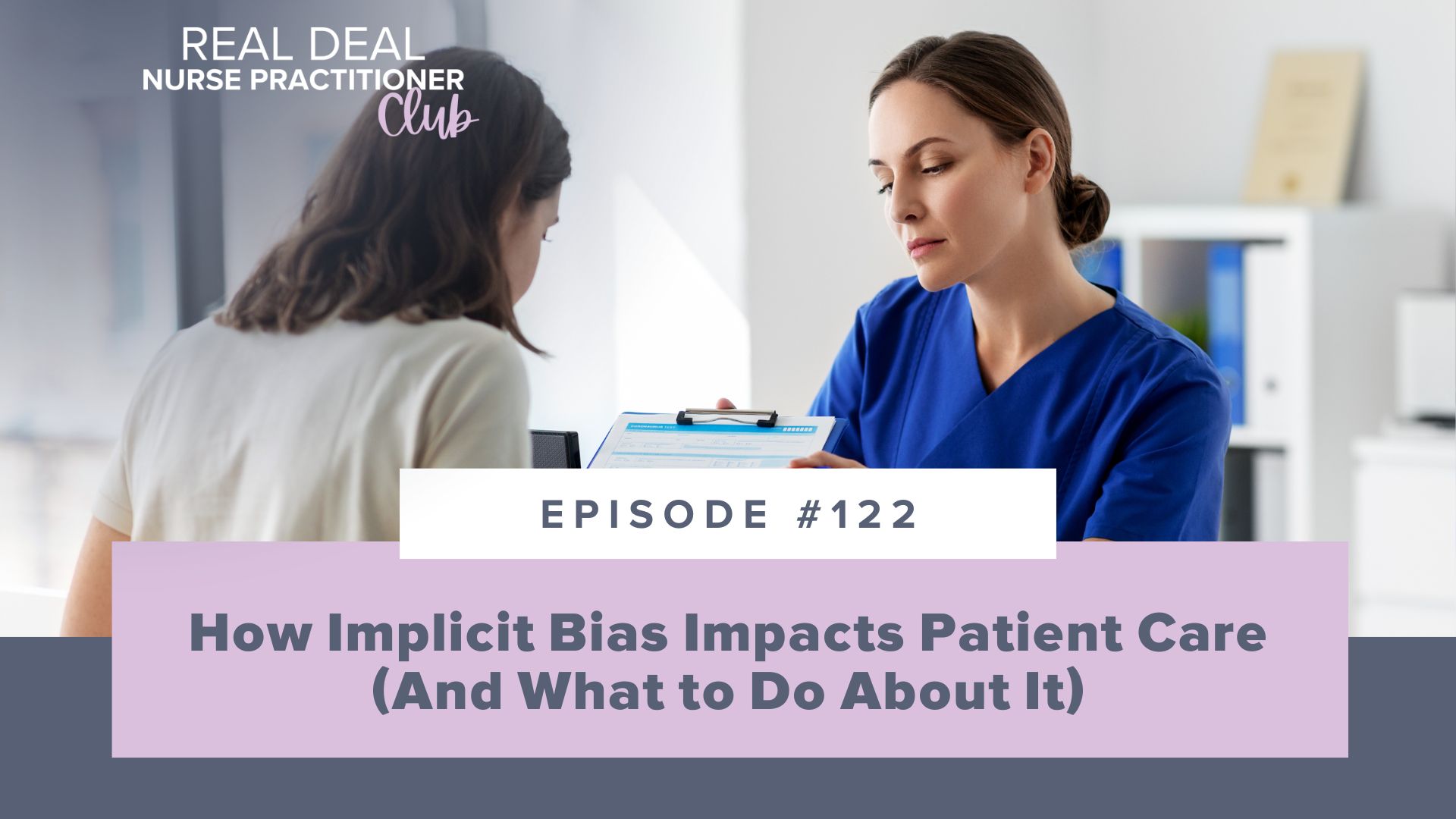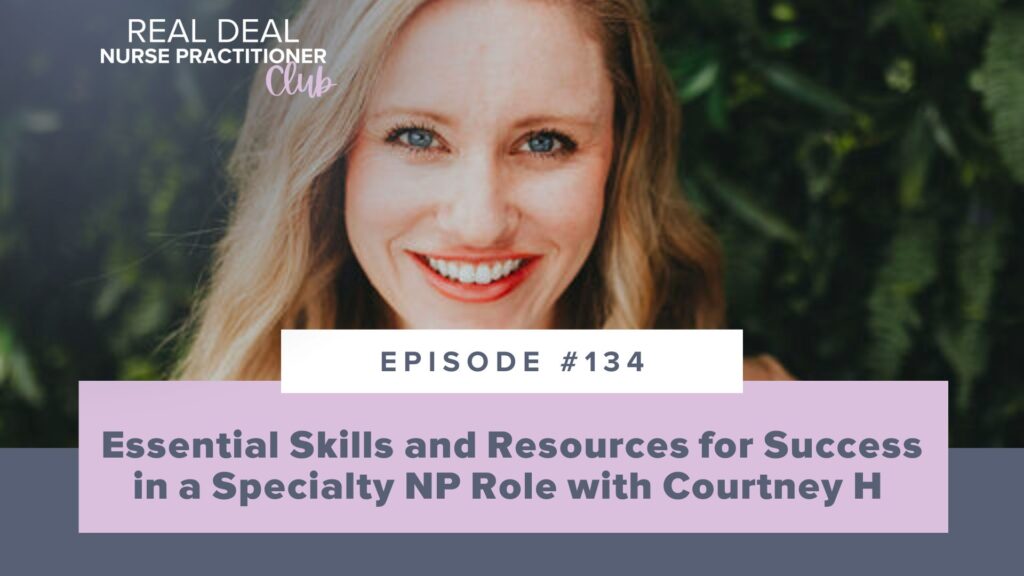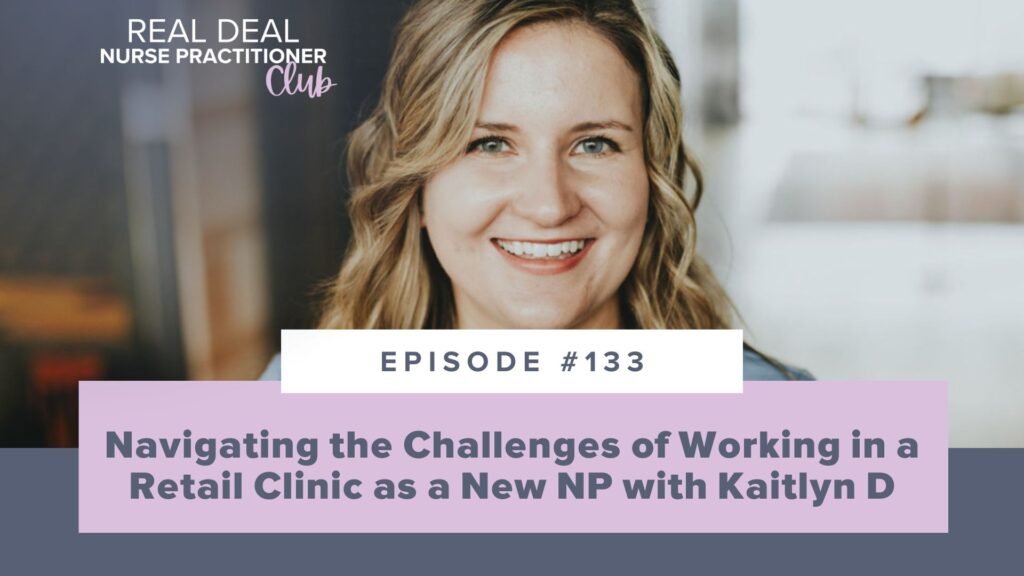Ep #122: How Implicit Bias Impacts Patient Care (And What to Do About It)
- by Sarah Michelle
- Sep 18, 2024
- Podcasts

Have you ever stopped to consider how your subconscious thoughts and stereotypes might be impacting the care you provide to patients as a Nurse Practitioner? It’s a tough question, but one that we as NPs need to grapple with if we want to deliver the best possible care.
In this episode, we dive deep into the concept of implicit bias: those unconscious judgments and assumptions we make about others based on characteristics like age, race, gender, and more. As healthcare providers, our implicit biases can have real consequences for our patients’ experiences and outcomes.
Join us today as we explore what implicit bias looks like in healthcare settings, how it can lead us astray in our clinical reasoning, and most importantly – what we can do to overcome it. With some honest self-reflection and a commitment to expanding our perspectives, we can all take steps to become more aware, sensitive, and equitable clinicians.
What You Will Discover:
- The various types of implicit bias that can impact healthcare.
- How implicit biases are shaped by our upbringing, environment, and even our brain’s tendency to categorize.
- Examples of how implicit bias can lead to flawed assumptions and disparities in patient care.
- Strategies for identifying your own implicit biases through self-reflection and exposure to diverse perspectives.
- How practicing mindfulness and exploring other cultures can help shift biased thought patterns.
Featured on the Show
- Follow me on: Facebook | Instagram | YouTube | TikTok
- Follow us on TikTok and YouTube!
- Check out our Job Hunt Course!
- Implicit bias in health care – The Joint Commission
Full Episode Transcript:

Welcome to the Real Deal NP Club. Whether you’re hoping to become a real deal nurse practitioner or you already are one, this is the place for you to get the resources you need as you tackle this massive transition into practice. We’re your hosts, Sarah Michelle, Chief Nursing Officer of Blueprint Test Prep, and Anna Miller, Director of Nursing Content. And we’re here to hang out with you each week like your best friends in the NP space. Let’s dive in.
Sarah: Hi, everyone. Today’s topic is going to take a bit of self-reflection and really just thinking about what kind of nurse practitioner clinicians we want to be. And so in this episode, we’re going to talk about understanding implicit bias. We’ll get into it a lot more, but implicit bias, also known as unconscious bias, if you’ve ever heard of it by that name, are just the different types of social stereotypes and judgments that we subconsciously assign to others based on things like age, socioeconomic status, weight, gender, sexual orientation, race, or ethnicity. So there’s a long list there. And our implicit biases affect our interactions with everyone, including our patients, which is why we are doing this episode.
And Anna is, of course, here with me today, and we’re going to be talking about some ways that we can identify and be aware, but also overcome our biases as well.
Anna: Yeah, absolutely. I mean, we’ll explore more what implicit biases are, what these different types are that you mentioned, but really how they affect the healthcare of our patients. And then of course, we are going to finish off by going over some ways to overcome your own implicit biases.
Sarah: And I think the biggest thing before we get started is just to join us with very open mind. I know it can be hard to think about sometimes and just try to get ready to self-reflect a little bit because this is all about your personal growth and making you the best nurse practitioner that you can be.
So first, just to talk more about what exactly implicit bias is, an online article by The Joint Commission defines it as the attitudes or stereotypes that affect our understanding, our actions, and our decisions in an unconscious manner. That unconscious word is very important. These biases, which encompass both favorable and unfavorable assessments, are activated involuntarily and without an individual’s awareness or intentional control. And so Anna, what are some of your thoughts on that?
Anna: Yeah, I wasn’t able to find exactly who this quote is attributed to, but I’ve heard it as the first thought you have about something is what you’ve been conditioned to think, and then what you think next defines who you truly are. And I think that quote, whoever said it, it works well with implicit bias, right?
We’ve all been raised differently and we’ve all been brought up to believe certain things, whether you know it or not. But then as nurses and nurse practitioners, we also know the importance of treating our patients equitably and with justice.
Sarah: Yeah, I really love that quote. I think that sums it up really nicely. And you know, those subconscious thoughts that creep in may have a basis in prejudice and stereotypes, but we need to acknowledge that internally, not act upon them, and then learn to have more sensitivity as well. So an example of an implicit bias is believing that all young people are better with technology than middle-aged or older adults, or people that don’t speak English well are less intelligent.
Both statements are clearly incorrect, but it may be how some people have been taught to subconsciously think.
Anna: Yeah, I love that you said that these implicit biases creep in, and it doesn’t mean that you’re a bad person. But it is important to acknowledge these subconscious thoughts so that you can work to overcome them. And so with that, I want to go a little further with the different types of implicit bias. The big categories include race and ethnicity bias, age bias, gender bias, LGBTQ bias, and ability bias. Now, race and ethnicity bias would be assuming someone of Asian descent is good at math, right?
That is that stereotype. What is an example of an age bias?
Sarah: Well, age bias could just be simply overlooking a job advocate due to their age, thinking someone who’s older would be wiser and have better experience pertinent to the position despite other factors, or oppositely, assuming that someone who’s older would not be able to keep up with a rigorous schedule someone who is younger.
Anna: Yeah, absolutely. And what are some causes of implicit bias? Can you go into that a little bit more?
Sarah: Well, there are a couple reasons. You know, we already talked about how it can be influenced by our upbringing. That’s a big one. And not just in the sense of how our parents or caregivers raise us, but also our exposure to media, books, entertainment, you know, anything that’s shaping our world. And another reason that I find really interesting is how our brains work.
So our brains want to organize things into these neat little categories and they want to find patterns. And so it’s actually easier for our brains to create these implicit biases than not.
Anna: That is really interesting. And we talk a lot about, you know, finding patterns and sorting into categories as we’re studying to help make. click and help remember them and so let’s just bring this topic back around to real DLNPs out there and let’s talk about how implicit biases affect the healthcare of our patients because they absolutely do. Many clinicians may hold an implicit bias that obesity is due to a lack of willpower or maybe they think that it’s the patient’s fault that they’re unable to maintain what they consider a healthy weight.
Or another example is that, you know, maybe a clinician thinks that despite the fact that cardiovascular disease is a leading cause of death and that women make up half the population, myocardial infarction symptoms in women are deemed atypical and this can be extremely misleading.
Sarah: And there’s so many more examples that we could talk about too, but just think about those two scenarios. If you carry an implicit bias that obesity is just a lack of willpower and inability to stick to a diet program. How do you think that might affect your interactions with patients who have obesity? Or, if you are caring for a woman with a possible myocardial infarction, will you be more likely to believe that they are truly cardiac in origin or less likely because of the patient’s sex? Those implicit biases can directly affect the patient’s healthcare experience.
Anna: Yeah, exactly. And not only the patient’s experience in terms of how positively or negatively the patient views their interaction with you, but also the patient’s willingness to seek care in the future, which is huge, right? Implicit biases can certainly contribute to the stigmatization.
Sarah: Another reason why overcoming implicit bias is important besides patient and cultural sensitivity, but it’s also because these contribute to cognitive errors, like errors in our diagnostic reasoning. So going back to the example of an atypical heart attack symptoms that are occurring in women, that belief may lead to delays in testing, delays in diagnosis, and that of course would worsen the patient’s outcomes. Implicit biases narrow our thinking and impact our ability to accurately diagnose and manage conditions.
Anna: Yeah, absolutely. And, you know, I think we’ve done a decent job so far about highlighting the harm in implicit bias, but what can we now do to overcome them?
Sarah: Well, the first thing that we would recommend is just to identify what your implicit biases are. So pay attention to those thoughts that pop up into your head when you’re talking to people, and not just your patients either. You know, what are the first things that come to mind When you hear someone talk about someone on the news or in a conversation with a friend. And remember, those first thoughts are what you’ve been conditioned to think.
In order to have that personal growth and to be the best nurse practitioner you can be, you have to recognize where they are first.
Anna: Yeah, that is so well said, right? Those implicit biases, they creep into all areas of our lives, not just our patient care. So we need to recognize them wherever they pop up. And once you’ve identified what your biases are, you can start to change your perspective and really put yourself in someone else’s shoes, right? I know that sounds cliche, but just try to see things from their perspective.
And it really takes a conscious effort on your part to change your frame of mind and your way of thinking. I also really like the recommendation of exploring other cultures. Now, this doesn’t mean you have to travel far, but just check out different areas in your neighborhood. Try new restaurants, new foods, visit different types of stores. It’s a really great way to meet new people and have new experiences.
Sarah: And lastly, one that I felt like people were resistant to, but something to consider, is practicing mindfulness as well. And this also includes self-reflection. So you can try things like meditation, mindful breathing techniques. And while it may not directly affect your implicit biases, it is great to learn to be more aware of your thoughts and feelings. And so we kind of talked about a little bit of a heavy topic today and implicit biases are things that we as humans all have. No one is going to be perfect, but the thing is if we can acknowledge the stereotypes that we hold and we can acknowledge how that can affect our ability to be compassionate holistic clinicians, then we’re off to a really great start, which is why we did this episode.
And Anna, what do you feel like is a big key takeaway here?
Anna: I really agree with what you just said. Nobody is perfect. Overcoming implicit biases is a never-ending process. There are always things that every single one of us, always, every single one of us, we need to be learning about ourselves and learning about others that can change our perspectives. And we have to be the ones to put in the work and do that self-reflection, even if And if you’re… to it, ask yourself why we have to do that self-reflection in order to have that kind of personal growth.
Sarah: Absolutely and by putting in that work we can better care for our patients and that’s really what being a real deal nurse practitioner is all about. But thank you for tuning in this week, listening about this harder topic and be sure to follow along with us, you know, podcasts obviously, you can follow us on YouTube as well, Facebook and we’ll be talking to you very soon.
Thanks for listening to the Real Deal Nurse Practitioner Club. If you want more information about the different types of support that we offer to students and new nurse practitioners, you can visit npreviews, with an S, dot com. We’ll see you next week.
Enjoy the Show?
- Don’t miss an episode: follow the podcast on Spotify, Apple Podcasts or RSS.
Related Posts
Search the Blog
Join our Facebook Group!
Get FREE support and encouragement from thousands of FNP/AGPCNP students and our NP Support team.
Learn More3 Study Hacks to Conquer Your NP Exam!
Download these tips that have helped thousands of students pass their NP board exams.
Download NowInstitutional Partnerships
Are you a faculty member and would like to bring Sarah Michelle’s resources to your school? Email us at nursinggroups@blueprintprep.com for special institutional pricing or click on the link below to learn more.
Learn MoreGroup Discounts
Are you a student and have 10 or more classmates interested in purchasing Sarah Michelle’s courses? Email us at nursinggroups@blueprintprep.com for special pricing.



